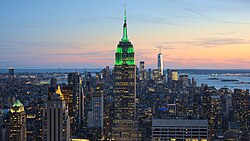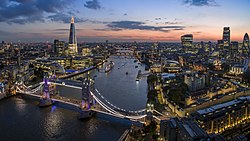Metropolis
A metropolis is a very big city,[1] that usually has over 500,000 people living in it.[2] A metropolis often has many smaller towns and cities in its metropolitan area.
The word began in ancient Greece,[1] from the words for "mother" and "city". It meant the city-state of origin of a colony. Later it came to mean the seat of a Bishop who also supervised the Church in other cities, or a city regarded as a center of some specified activity, or a large and important city. In India a "metropolis" is a city with more than a million people.
In the past many large cities were called metropolitan due to their size or importance; such as: Alexandria, Angkor, Antioch, Athens, Babylon, Baghdad, Beirut, Benares, Byblos, Carthage, Constantinople, Corinth, Damascus, Ephesus, Great Zimbabwe, Harappa, Jerusalem, Kangla, Nanjing, Nineveh, Macchu Picchu, Mohenjo-Daro, Rome, Sarai, Side, Syracuse, Tenochtitlan, Teotihuacan, Tikal, Tyre, Xian and Ur.
The modern metropolises are increasing day by day in this world since pre-21st century.
Africa
North America
Middle America
South America
Eastern Asia
Southern Asia
Southeastern Asia
Western and Central Asia
Europe
Central Europe
Eastern Europe
Northern Europe
Southern Europe
Western Europe
Oceania
Metropolis Media
Skyline of Tokyo, the world's most populous metropolis
Skyline of London, which was once the metropole of the British Empire
Metro Manila, the most populous metropolitan area in the Philippines
Skyline of Paris, which is the most populated urban area in the European Union.
Related pages
References
- ↑ 1.0 1.1 United Nations, "Population density and urbanization"; compare Werner Staub and Dirk Krischenowki. "GeoTLDs – Diversity, Multilingualism and Local Content," Archived 2012-02-26 at the Wayback Machine Internet Governance Forum, Oct 30 – Nov 2, 2006, p. 31 n4; excerpt, "The United Nations has set up its own classifications scheme: a "big city" is a locality with 500,000 or more inhabitants; a "city" is a locality with 100,000 or more inhabitants; an "urban locality" is a locality with 20,000 or more inhabitants; a "rural locality" is a locality with less than 20,000 inhabitants ..."; retrieved 2013-4-24
- ↑ Metropolis Association A full member is either a capital city or a city with more than one million inhabitants, City Mayors: Metropolis World Congress. Retrieved 15 July 2006.
- Allen J. Scott (ed.) Global City Regions: Trends, Theory, Policy, Oxford University Press (2001).
- Monti, Daniel J., Jr., The American City: A Social and Cultural History. Oxford, England and Malden, Massachusetts: Blackwell Publishers, 1999. 391 pp. ISBN 978-1-55786-918-0.
Other websites
- U.S. Census Bureau: About Metropolitan and Micropolitan Statistics
- Megalopolis, my Arcadia Archived 2012-12-10 at Archive.today, a podcast with a worldwide analysis of megacities (focus Latin America)








